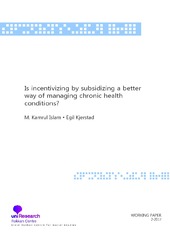| dc.contributor.author | Islam, M. Kamrul | |
| dc.contributor.author | Kjerstad, Egil | |
| dc.date.accessioned | 2018-01-11T09:33:08Z | |
| dc.date.accessioned | 2020-12-10T06:33:41Z | |
| dc.date.available | 2018-01-11T09:33:08Z | |
| dc.date.available | 2020-12-10T06:33:41Z | |
| dc.date.issued | 2017-09 | |
| dc.identifier.issn | 1503-0946 | |
| dc.identifier.uri | https://hdl.handle.net/1956/17180 | |
| dc.description.abstract | The recognition that chronic care delivery is sub‐optimal has led many health authorities around the world to its redesign. In Norway, the Department of Health implemented the Coordination Reform in January 2012 with the granting of subsidies to municipalities establishing emergency bed capacity (EBC) within their primary care facilities, with the explicit aim of reducing unnecessary admissions to hospitals. We examine the impact of this EBC policy on changes in emergency hospital admissions. Municipalities took advantage of these subsidies at different points of time, which means that there are differences in the local implementation of EBC, enabling us to use an identifying restriction to define the treatment and control groups. Using five different sources of register data and a quasi‐experimental framework (the differencein‐ differences regression approach), we estimate the causal effect of the changes in EBC on aggregate emergency admissions for eight ambulatory care sensitive conditions (ACSCs). We also estimate the impact on each condition separately. The results show that EBC exerted a significant and negative effect on the changes in emergency admissions. The effects are largely consistent with alternative model specifications but we find mixed results for the different ACSCs, in that EBC negatively affected emergency hospital admissions for angina and chronic obstructive pulmonary disease, but not congestive heart failure and diabetes. The main implication of the study is that EBC within primary care is a sensible way of redesigning chronic care as it leads to a meaningful reduction in hospital emergency admissions. | en_US |
| dc.language.iso | eng | eng |
| dc.publisher | Stein Rokkan Centre for Social Studies | eng |
| dc.relation.ispartofseries | Working paper; 2-2017 | eng |
| dc.subject | Incentives | eng |
| dc.subject | Emergency bed capacity | eng |
| dc.subject | Emergency admissions | eng |
| dc.subject | Subsidies | eng |
| dc.subject | Difference‐in‐differences | eng |
| dc.title | Is incentivizing by subsidizing a better way of managing chronic health conditions? | eng |
| dc.type | Working paper | eng |
| dc.rights.holder | Copyright Stein Rokkan Centre for Social Studies. All rights reserved. | eng |
| dc.description.version | publishedVersion | |
| dc.subject.nsi | VDP::Samfunnsvitenskap: 200 | |
